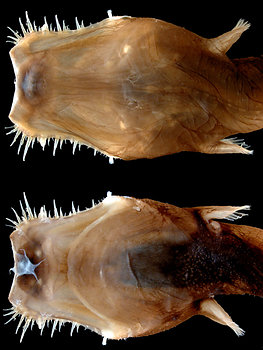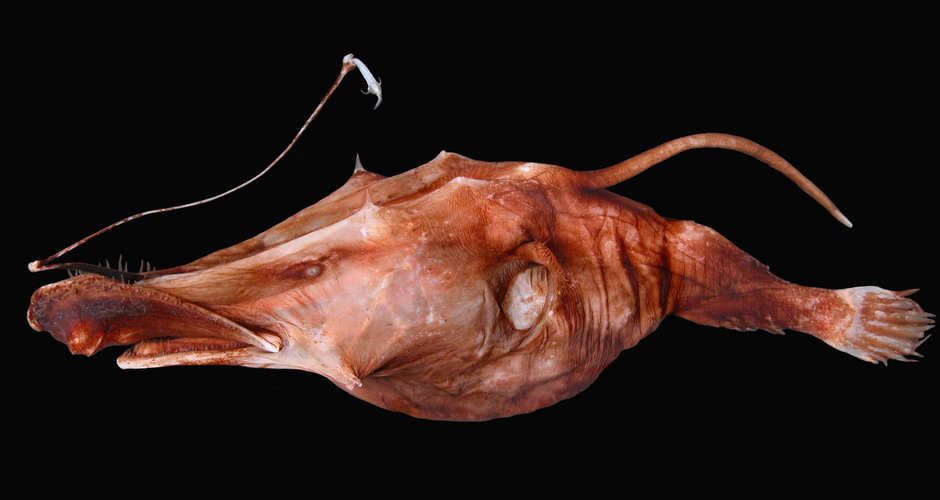Thaumatichthyidae
Wolftrap Seadevils
Theodore W. Pietsch


This tree diagram shows the relationships between several groups of organisms.
The root of the current tree connects the organisms featured in this tree to their containing group and the rest of the Tree of Life. The basal branching point in the tree represents the ancestor of the other groups in the tree. This ancestor diversified over time into several descendent subgroups, which are represented as internal nodes and terminal taxa to the right.

You can click on the root to travel down the Tree of Life all the way to the root of all Life, and you can click on the names of descendent subgroups to travel up the Tree of Life all the way to individual species.
For more information on ToL tree formatting, please see Interpreting the Tree or Classification. To learn more about phylogenetic trees, please visit our Phylogenetic Biology pages.
close boxIntroduction
Thaumatichthyids are among the most bizarre of anglerfishes, characterized by having large tooth-like denticles associated with the esca, but more striking, an enormous upper jaw that extends far forward, each premaxilla bearing numerous long hooked teeth. The premaxillae, with their extraordinarily long teeth are capable of flipping up and down to enclose, when in the ventral position, the much shorter lower jaw, forming a cage-like compartment within which prey are held prior to swallowing, reminiscent of the Venus fly-trap among carnivorous plants.
The family Thaumatichthyidae contains eight currently recognized species in two genera, Thaumatichthys Smith and Radcliffe (1912) and Lasiognathus Regan (1925). Like many ceratioid taxa, the thaumatichthyids are rare and only know from just over 60 specimens.
Characteristics


Dorsal (top) and ventral (bottom) views of Thaumatichthys binghami, UW 47537. The ventral view diplays the sessile esca on the roof of the mouth. © 2005 University of Washington
Diagnosis
Metamorphosed females of the family Thaumatichthyidae are distinguished from those of all other ceratioid families by having elongate premaxillae that extend anteriorly far beyond the lower jaw, the bones widely separated anteriorly at the symphysis but connected by a broad elastic membrane; teeth on premaxillae extremely long, curved or hooked; esca bearing 1-3 large tooth-like dermal denticles; and opercle bifurcate, dorsal fork divided into two or more branches.
Description
Metamorphosed females are further differentiated by having the following combination of character states: supraethmoid well developed (Lasiognathus), very much reduced or absent (Thaumatichthys); frontals long, narrow, and widely separated, ventromedial extensions present (Lasiognathus) or absent (Thaumatichthys); parietals present; sphenotics large, spine extremely well-developed (Lasiognathus) or small, conical, without spine (Thaumatichthys); pterosphenoid, metapterygoid, and mesopterygoid present; hyomandibular with a double head; hypohyals 2; branchiostegal rays 6 (2 + 4); subopercle long and narrow (Thaumatichthys) or short and oval (Lasiognathus), posterior margin of dorsal part without indentation, ventral part with (Thaumatichthys) or without (Lasiognathus) spine or projection on anterodorsal margin; quadrate and articular spines very well-developed (Lasiognathus) or rudimentary (Thaumatichthys); angular and preopercular spines absent; lower jaw without symphysial spine; postmaxillary process of premaxilla absent; anterior-maxillomandibular ligament reduced (Thaumatichthys) or absent (Lasiognathus); pharyngobranchials I and IV absent; pharyngobranchials II and III well developed and toothed; hypobranchials 1-3 present; only a single ossified basibranchial; epibranchial and ceratobranchial teeth absent; epibranchial I bound to wall of pharynx; proximal one-half to two-thirds of ceratobranchial I bound to wall of pharynx; distal end of ceratobranchial I free, not bound by connective tissue to adjacent ceratobranchial II; proximal one-quarter to one-half of ceratobranchials II-IV not bound together by connective tissue; epurals absent; posterior margin of hypural plate entire (Lasiognathus) or deeply notched (Thaumatichthys); pterygiophore of illicium bearing a small ossified remnant of second cephalic spine; escal bulb and central lumen present; posteroventral process of coracoid absent; pectoral radials 3; pelvic bones cylindrical, only slightly expanded distally; dorsal-fin rays 5-7; anal-fin rays 4-5; pectoral-fin rays 14-20; caudal-fin rays 9 (2 simple + 4 bifurcated + 3 simple); skin everywhere naked, dermal spinules absent (Lasiognathus), or present on ventral surface of head and body of metamorphosed specimens (Thaumatichthys); ovaries paired; pyloric caecae absent.
Males and larvae are known only for Thaumatichthys.
Classification
Regan (1925, 1926), followed by Regan and Trewavas (1932), Bertelsen (1951), and Maul (1961, 1962), included Lasiognathus in the family Oneirodidae, together with Thaumatichthys, which was originally placed in a family of its own, the Thaumatichthyidae Smith and Radcliffe (1912). Pietsch (1972) resurrected the Thaumatichthyidae to include both Lasiognathus and Thaumatichthys. Bertelsen and Struhsaker (1977) compared the osteology of Thaumatichthys and Lasiognathus, pointing out that the latter appears more closely related to the Oneirodidae in several of the characters in which it differs from Thaumatichthys. The Oneirodidae, however, is undefined cladistically (a long list of characters in combination, some or none of which may be derived, is presently required to contain the 16 morphologically diverse oneirodid genera; see Pietsch, 1974). Bertelsen and Struhsaker (1977:34) noted, therefore, that “it becomes a subjective choice whether the genera Lasiognathus and Thaumatichthys both should be included in the Oneirodidae as Regan (1926) did, or placed together in Thaumatichthyidae as proposed by Pietsch (1972), or whether each of them should be referred to a family of its own.” At the same time, however, they cited the two unique features used by Pietsch (1972) to diagnose the Thaumatichthyidae (premaxillae extending anteriorly far beyond lower jaw, and enlarged dermal denticles associated with the esca) and added a third (dorsal portion of opercle divided into two or more branches). In the end, they chose to retain the Thaumatichthyidae in the enlarged sense as proposed by Pietsch (1972).
Distribution
The 27 known specimens of Lasiognathus were collected from widely scattered localities in the Atlantic and Pacific oceans between approximately 47°N and 35°S. The 33 known specimens of Thaumatichthys are worldwide in distribution between approximately 32°N and 27°S.
Key to the Known Genera of Thaumatichthyidae
1A. Head narrow; pterygiophore of illicium long, anterior end emerging on snout from between frontal bones; illicium long, greater than 35% SL; esca at tip of illicium, bearing two or three large tooth-like denticles; skin naked, dermal spinules absent; dorsal-fin rays 5; anal-fin rays 5 (Lasiognathus Regan, 1925)
1B. Head broad, depressed; pterygiophore of illicium short, completely hidden beneath skin of head; illicium short, nearly fully enveloped by tissue of esca; esca sessile on roof of mouth, with one deeply embedded dermal denticle; dermal spinules present in skin of ventral surface of head and body; dorsal-fin rays 6-7; anal-fin rays 4 (Thaumatichthys Smith and Radcliffe, 1912)
References
Bertelsen, E. 1951. The ceratioid fishes. Ontogeny, taxonomy, distribution and biology. Dana Rept., 39, 276 pp.
Bertelsen, E., and P. J. Struhsaker. 1977. The ceratioid fishes of the genus Thaumatichthys: Osteology, relationships, distribution, and biology. Galathea Rept., 14: 7–40.
Maul, G. E. 1961. The ceratioid fishes in the collection of the Museu Municipal do Funchal (Melanocetidae, Himantolophidae, Oneirodidae, Linophrynidae). Bol. Mus. Mun. Funchal, 14(50): 87-159.
Maul, G. E. 1962. On a small collection of ceratioid fishes from off Dakar and two recently acquired specimens from stomachs of Aphanopus carbo taken in Madeira (Melanocetidae, Himantolophidae, Diceratiidae, Oneirodidae, Ceratiidae). Bol. Mus. Mun. Funchal, 16(54): 5-27.
Pietsch, T. W. 1972. A review of the monotypic deep-sea anglerfish family Centrophrynidae: Taxonomy, distribution, and osteology. Copeia, 1972(1): 17–47.
Pietsch, T. W. 1974. Osteology and relationships of ceratioid anglerfishes of the family Oneirodidae, with a review of the genus Oneirodes Lütken. Nat. Hist. Mus. L. A. Co., Sci. Bull., 18, 113 pp.
Pietsch, T. W. 2005. A new species of the ceratioid anglerfish genus Lasiognathus Regan (Lophiiformes: Thaumatichthyidae) from the Eastern North Atlantic off Madeira. Copeia, 2005(1): 77-81.
Regan, C. T. 1925b. New ceratioid fishes from the N. Atlantic, the Caribbean Sea, and the Gulf of Panama, collected by the “Dana.” Ann. Mag. Nat. Hist., Ser. 8, 8(62): 561–567.
Regan, C. T. 1926. The pediculate fishes of the suborder Ceratioidea. Dana Oceanogr. Rept. 2, 45 pp.
Regan, C. T., and E. Trewavas. 1932. Deep-sea anglerfish (Ceratioidea). Dana Rept., 2, 113 pp.
Smith, H. M., and L. Radcliffe. 1912. Scientific results of the Philippine Cruise of the fisheries steamer "Albatross," 1907–1910, No. 20. Description of a new family of pediculate fishes from Celebes. Proc. U. S. Nat. Mus., 42: 579–581.
Title Illustrations

| Scientific Name | Lasiognathus amphirhamphus Pietsch |
|---|---|
| Location | Off southwest coast of Madeira |
| Specimen Condition | Dead Specimen |
| Sex | Female |
| Image Use |
 This media file is licensed under the Creative Commons Attribution-NonCommercial License - Version 3.0. This media file is licensed under the Creative Commons Attribution-NonCommercial License - Version 3.0.
|
| Copyright |
© Theodore W. Pietsch

|
About This Page
Theodore W. Pietsch

University of Washington, Seattle, Washington, USA
Correspondence regarding this page should be directed to Theodore W. Pietsch at
Page copyright © 2005 Theodore W. Pietsch
 Page: Tree of Life
Thaumatichthyidae. Wolftrap Seadevils.
Authored by
Theodore W. Pietsch.
The TEXT of this page is licensed under the
Creative Commons Attribution-NonCommercial License - Version 3.0. Note that images and other media
featured on this page are each governed by their own license, and they may or may not be available
for reuse. Click on an image or a media link to access the media data window, which provides the
relevant licensing information. For the general terms and conditions of ToL material reuse and
redistribution, please see the Tree of Life Copyright
Policies.
Page: Tree of Life
Thaumatichthyidae. Wolftrap Seadevils.
Authored by
Theodore W. Pietsch.
The TEXT of this page is licensed under the
Creative Commons Attribution-NonCommercial License - Version 3.0. Note that images and other media
featured on this page are each governed by their own license, and they may or may not be available
for reuse. Click on an image or a media link to access the media data window, which provides the
relevant licensing information. For the general terms and conditions of ToL material reuse and
redistribution, please see the Tree of Life Copyright
Policies.
- First online 06 November 2005
Citing this page:
Pietsch, Theodore W. 2005. Thaumatichthyidae. Wolftrap Seadevils. Version 06 November 2005 (under construction). http://tolweb.org/Thaumatichthyidae/22007/2005.11.06 in The Tree of Life Web Project, http://tolweb.org/







 Go to quick links
Go to quick search
Go to navigation for this section of the ToL site
Go to detailed links for the ToL site
Go to quick links
Go to quick search
Go to navigation for this section of the ToL site
Go to detailed links for the ToL site